Mercedes-Benz 770
The Mercedes-Benz 770, also known as the Großer Mercedes (German for "Grand Mercedes"), was a large luxury car built by Mercedes-Benz from 1930 to 1943. It is probably best known from its use by high-ranking Reich officials before and during World War II, including Adolf Hitler, Hermann Göring, Heinrich Himmler and Reinhard Heydrich, as captured in archival footage.
| Mercedes-Benz Type 770 | |
|---|---|
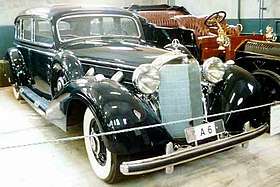 Mercedes-Benz 770 (W150) | |
| Overview | |
| Manufacturer | Mercedes-Benz |
| Also called |
|
| Production |
|
| Assembly | |
| Body and chassis | |
| Class | Full-size luxury car |
| Body style | 4-door, 6-seat Pullman (limousine) Touring car (6 seats) Cabriolet |
| Layout | FR layout |
| Powertrain | |
| Engine |
|
| Dimensions | |
| Wheelbase |
|
| Length |
|
| Width |
|
| Chronology | |
| Predecessor | Mercedes-Benz 630 |
| Successor | Mercedes-Benz W186 (1951) |
Series I - W07 (1930–1938)
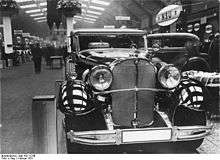
The 770 was introduced in 1930 as the successor to the Mercedes-Benz Typ 630, with the internal code W07.[1] These high-priced cars were mainly used by governments as state vehicles.[2] Reich President Paul von Hindenburg, Emperor Hirohito and Pope Pius XI were among the customers, and Adolf Hitler used a 770 from 1931 onwards. 117 W07-series cars were built until 1938.[2]
The W07 version of the 770 was powered by an inline eight-cylinder engine of 7,655 cc (467.1 cu in) capacity with an overhead camshaft and aluminium pistons.[1][2][3][4] This engine produced 150 bhp (112 kW) at 2800 rpm without supercharging.[1][3][5] An optional Roots type supercharger, which was engaged at full throttle, would raise the output to 200 bhp (149 kW) at 2800 rpm, which could propel the car to 160 km/h (99 mph).[1][2] The transmission had four forward ratios, of which third was direct and fourth was an overdrive.[3][6]
The W07 had a contemporary boxed chassis suspended by semi-elliptic leaf springs onto beam axles front and rear.[2] Dimensions would vary with coachwork, but the chassis had a wheelbase of 3,750 mm (147.6 in) and a front track equal to the rear track of 1,500 mm (59.1 in).[1]
Series II - W150 (1938–1943)
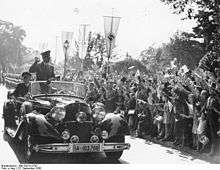
The 770 was substantially revised in 1938, resulting in the new internal designation of W150.[7] The all-new chassis was made with oval section tubes and was suspended from coil springs all around, with independent suspension at front and a de Dion axle at the rear.[2] Hydraulic brakes were fitted, compared to the servo-assisted mechanical brakes of the prior series.
The engine had the same basic architecture as that of the W07, but had been tuned to produce 155 bhp (116 kW) at 3000 rpm without supercharging and 230 bhp (172 kW) at 3200 rpm with.[7] The transmission now had five forward ratios with a direct fourth gear and an overdrive fifth.[2][7] Top speed was around 170 km/h (106 mph). A twin-supercharged 400 hp (298 kW) model was available, able to reach a top speed of around 190 km/h (118 mph). A total of five were made.
In 1938, the huge W150 was understood to have been the most expensive German passenger car for sale up to that time, though it appeared on no price list: the price was published merely as auf Anfrage ("upon request").[8] Eighty-eight W150-series cars were built before chassis production ended in 1943. The last cars were bodied and delivered in March 1944.[2][7]
Some cars of this model were offered by Hitler as gifts to his allies, namely: Marshal Ion Antonescu of Romania, Benito Mussolini of Italy, Francisco Franco of Spain, Marshal Carl Gustaf Emil Mannerheim of Finland and Emil Hácha of the Bohemian Protectorate.[9] Marshal Antonescu's car, for instance, was bulletproof.[10]
Surviving 770s
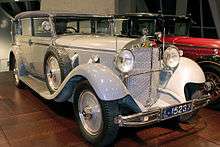
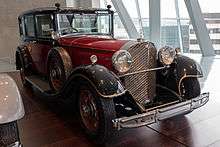
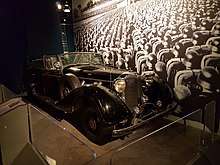
The Canadian War Museum in Ottawa has on display one of seven cars used by Hitler. Heavily modified with extensive armour plating – including 2.5 inch glass all round, and 1.6 inch steel armour plate in all metalwork surrounding the main passenger compartment, plus an additional raiseable plate between driver and rear passenger compartment – it weighs 4,100 kgs. Further modifications allowed the secure storage of three machine pistols. The body also had additional vents to the side and a top the hood, twin hinges on the side doors, and four further air vents in the main scuttle. In preparation of the fall of Berchtesgarden in April 1945, RSD and SS troops had loaded the car on a railway flat-car, where it was found in May 1945 by a troops of the United States Army 20th Armored Division in Laufen. Found in a damaged condition, a liberated Dutch forced-labour mechanic got the car working, advising the troops that it was Hermann Goering's state car. Repainted in US Army green with a star applied either side, it then served as the ranking officer's staff car during the post-war occupation period of Germany. Shipped to the U.S. in late 1945, it toured the country as part of a continued effort to raise war bonds, displayed and noted as Goering's personal car. Placed in storage, in October 1956 it was entered in a US Army surplus auction at Aberdeen Proving Ground, and sold to Montreal-based businessman for $2,750. Shipped for restoration to Rumble Motors in Toronto, a research book was established to restore the car as Goering would have had it during the war – for a cost of Can$5,000 – apart from leaving the bullet-damaged glass in place. In 1970 as part of a tax settlement, the car was gifted to the Canadian War Museum, again displayed there as Goering's car. In 1980, museum researcher Ludwig Kosha – originally himself born in Germany – began detailed research on the car, with assistance from Mercedes-Benz, the West German embassy to Canada and the West German foreign service. Along with chassis, engine, paint and modification records, and discovery of part of its original number plate 1AV148697, it was confirmed as one of Hitler's cars, delivered to the Reich Chancellery, Berlin on 8 July 1940.[11][12]
The 770K originally owned by Field Marshal of Finland Baron Gustav Mannerheim was sold to an American collector after World War II. It was featured in the 1951 motion picture The Desert Fox: The Story of Rommel as Hitler's parade car.[13] In 1973, Mannerheim's 770K, erroneously alleged to have been the parade limousine of Adolf Hitler, was sold at auction for $153,000, which was the most money ever paid for a car at auction at that time.[14] This broke the previous record price for an antique car, which had been $90,000 for Greta Garbo's Duesenberg in autumn 1972. It was sold to a businessman from Lancaster, Pennsylvania, who wanted the car for a park called Dutch Wonderland. Since 1984, Mannerheim's car has been privately owned.[15]
Another 770 was sold at the same 1973 auction, for $93,000. The high bidder was an Alabama developer and campaign manager for George Wallace's campaign in the 1964 U.S. presidential election. However, he could not secure financing to complete the transaction and subsequently sold his option to a mobile-home manufacturer.
As of November 2009, one of Hitler's 770Ks was allegedly purchased for several million euros by an unnamed Russian billionaire.[16]
In the Norwegian Mercedes Benz Club's magazine of June 2010 is an article on a 770 Offener Tourenwagen (W150). It was brought to Norway in 1941 by General Nikolaus von Falkenhorst. After World War II, it was used by the King of Norway. It was later sold to a buyer in the United States. The car won the prize for the best unrestored pre-war car at the Pebble Beach Concours d'Elegance in 2003.
Two other 770s were brought to Norway during the war, one for Josef Terboven and the other for Vidkun Quisling. The Norsk Motorveteran magazine had a short article on one of the cars, which stated that it was displayed for sale to the public but apparently no one wanted to buy it despite the low price of KR 50,-. It was eventually scrapped, and all that now remains of the car is part of the bulletproof glasswork. The other car, a 1939 cabriolet, made its way to Czechoslovakia where it was used as a VIP transport for state functions. In 1948 the communists took over and in 1952 it was sent to the Vysoké Myto body works and given a new body and interior, in order to remove any of its “imperialist” origins, and as such has no external indicators of its original manufacture. This car is on display at the National Technical Museum In Prague.
There is a 1938 Mercedes-Benz 770 Grosser at the Museu do Caramulo in Portugal. This car is armoured and was ordered by the PVDE, the Portuguese internal secret police, after the 1937 bomb attempt against the Portuguese dictator António Salazar.
A black 1938 770K, on display at the Technisches Museum in Sinsheim, Germany, allegedly was owned by the German central government office and used by Adolf Hitler during parades. The car was fitted with mine-proof floor armour, plus thick glass and bodywork. However, as a convertible parade car, the occupants' protection was limited.[17]
There is a 1939 770K on display at the Southward Car Museum at Paraparaumu in New Zealand. It is believed to have been intended as a gift for Edward VIII after the planned German invasion of Britain.
A 1939 770K Cabriolet B has made at least one appearance at the Pebble Beach Concours d'Elegance in California. This car is a 2-door, 5-passenger convertible, making it particularly unusual since the majority of W150 cars were built as hardtop limousines or convertible limousines. It is finished in dark red with a tan leather interior.[18]
The Spanish Royal Guard has a 770 in the Royal Palace of El Pardo in Madrid, which was used by Francisco Franco.
A 770k once owned by His Majesty King Abdullah I of Jordan on display in the Royal Automobile Museum there.
References
- "Oldtimers Gallery - Mercedes-Benz 770 W07(K) Grosser". Autogallery.org.ru. Retrieved 2010-12-31.
- Robson, Graham (1990). The World's Most Powerful Cars. Quintet Publishing. pp. 100–101. ISBN 1-85076-254-6.
- Ruiz, Marco (1988). The History of the Automobile. W.H. Smith Publishers. p. 57. ISBN 0-8317-6550-X.
- Rogliatti, Gianni (1973). Cyril Posthumus (ed.). Period Cars. Feltham, Middlesex, UK: Hamlyn. pp. 94–95. ISBN 0-600-33401-5.CS1 maint: ref=harv (link)
- Rogliatti 1973, p. 94.
- Rogliatti 1973, p. 95.
- "Oldtimers Gallery - Mercedes-Benz 770 W150 Grosser". Autogallery.org.ru. Retrieved 2010-12-31.
- "Als der Fürerschein eine Mark kostet: B Busch blickt in den Rückspiegel: 1938". Auto Motor u. Sport. Heft 19 1976: Seite 76–82. 15 September 1976.
- Samohýl Ladislav, Vacek Zdeněk, Fenomén Mercedes-Benz & Čechy, Morava a Slezsko, Grada Publishing, 2015, p. 34
- Corneliu Leu, The Novel of a Great Day, "Realitatea" Publishers Ltd, 2005, p. 130
- Klara, Robert. The Devil's Mercedes.
- Pulsifer, Cameron (Fall 1999). ""Hitler's Car" and the Canadian War Museum: Problems of Documentation and Interpretation". Material Culture Review. 50: 67–75 – via University of New Brunswick.
- "Mannerheim's Mercedes Benz 770 F-Cabriolet". Mannerheim.fi. Retrieved 2010-12-31.
- "This Day In History: January 6". History.com. Archived from the original on 2007-10-07. Retrieved 2010-12-31.
- "Hitler's car exerts grim fascination even if it just gave the Führer a lift to the airport". The Guardian. 13 September 2015. Retrieved 4 June 2017.
- "Russian Billionaire Buys Hitler's Mercedes: Report". Abc.net.au. 2009-11-24. Retrieved 2010-12-31.
- "Mercedes-Benz 770K Cabriolet". Sinsheim Auto & Technik Museum. Archived from the original on 16 May 2012. Retrieved 29 February 2012.
- http://www.conceptcarz.com/vehicle/z12046/Mercedes-Benz-770-K-Cabriolet-B.aspx 1939 Mercedes-Benz 770K Cabriolet B
Further reading
- Klara, Robert (2017). The Devil's Mercedes: The Bizarre and Disturbing Adventures of Hitler's Limousine in America. New York: Thomas Dunne Books. ISBN 9781250069726.
External links
| Wikimedia Commons has media related to Mercedes-Benz W07. |
| Wikimedia Commons has media related to Mercedes-Benz W150. |